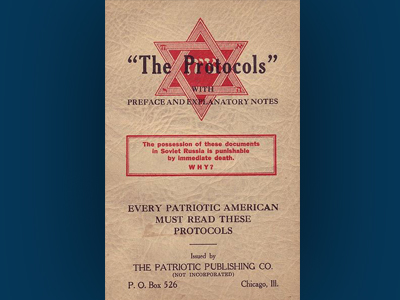Protocols of the Elders of Zion Is Published

August 26, 1903
The Protocols of the Elders of Zion, the most widely distributed antisemitic publication in modern history, is first published in Znamya, a Russian newspaper. A plagiarized version of an 1864 French political satire by Maurice Joly, Dialogue in Hell Between Machiavelli and Montesquieu, Protocols most likely was written in Paris at the end of the 19th century. Protocols‘ dialogue comes from Joly’s work, which contains no references to Jews or Judaism, but is altered to represent the proceedings of a conference of worldwide Jewish leaders. The fictitious Jewish conference may have been an allusion to the First Zionist Congress in 1897.
Protocols played on traditional anti-Jewish stereotypes and depicted a secret Jewish conspiracy for world domination through manipulation and corruption. It states:
The people of Israel must direct its ambition towards the height of power which brings esteem and honors. The surest means of attaining it is to have control over all industrial, financial and commercial operations, while carefully avoiding every trap and temptation which might expose one to legal proceedings in the country’s courts. In its choice of speculation the children of Israel will therefore display the prudence and tact which are the mark of its congenital talent for business. (As reprinted by Paul Mendes-Flohr and Jehuda Reinharz, The Jew in the Modern World, Second Edition, New York: Oxford University Press, 1995, p. 362)
The publication receives little attention initially but is widely distributed and translated after World War I and the Russian Revolution. It is a major contributor to incitement against Jews during the pogroms that swept Russia from 1918 to 1920. Despite being proved as a fraud in 1921 by The Times of London, Protocols continues to gain circulation and readers. It is used in Nazi propaganda in the 1930s and 1940s and by contemporary haters of Jews, especially online.